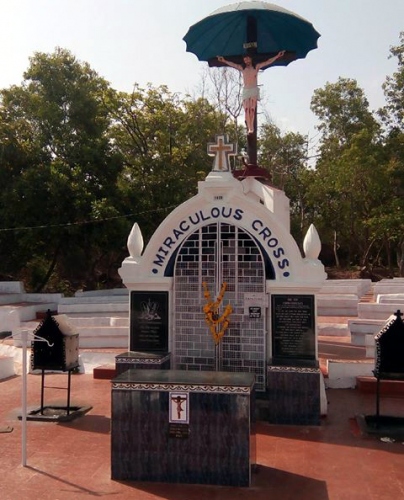
The Anjuna Church was founded in 1603 and dedicated to St Michael, the Archangel known as Sao Miguel Arcanjo Igreja em Anjuna in Portuguese. The original building of the Church was demolished and rebuilt in 1713 and enlarged further in 1897.
Not very far from the Church, in Igreja Vaddo, at the peak of the hill is Milagrincho Khuris (Miraculous Cross), sought by those in need of God’s assistance and who seek quietness and solace.
In the past, it was also called Dongravoilo Khuris (Cross from the hill) or Gorvam Raknneancho Khuris (Cowherd's Cross), because during the monsoon season when cowherds grazed their cattle on the hill, whenever it rained, they took shelter in it
As regards the origin of the cross, some say it goes back to the year 1602, when the Franciscans, while constructing the church, sent labourers up the hill to fetch stones. To seek protection from wild animals lurking in the forest and from other hazards during the operation, they constructed the cross with just three laterite stones on a rock. Since then, residents of Igreja Vaddo began worshipping the Cross.
The Cross was not visited frequently in olden times except when people went to collect churnam and kannttam (wild fruits). The other occasion when people visited the Cross was when there was a delay in rains or if it rained and suddenly stopped, causing the fields to dry.
If this happened, people from Gaumvaddy, Igrez Vaddo, St Sebastian Vaddo and other Vaddos would gather in the compound of St John's chapel and march on foot towards the Milagrincho Khuris. Each person carried a sizeable stone on his/her head, as a penance. People would sing religious hymns and pray throughout the journey.
On reaching the foot of the Cross, all knelt on the rocky ground and prayed fervently for rainfall. Such was the faith of these people that by the time they climbed down the hill, they would experience light showers; sometimes it would even rain quite heavily. Indeed, it was a miracle!
Others say it originated around the time when the village was passing through the throes of a great plague in 1908. The death toll was so high that the bodies had to be cremated. The only ray of hope for the villagers was the Miraculous Cross.
The Anjuna residents prayed fervently to the Miraculous Cross to save them from this deadly disease and even vowed to build a chapel enclosing the cross in Thanksgiving. Their prayer was heard and many villagers were saved from the disease.
The little Capelina (chapel) was built in 1929 in gratitude. In January 1930, on the feast of Nossa Senhora Advogada dos Pecadores, the Miraculous Cross was blessed by Fr Jose Leandro de Abreu, then Vicar of St Michael Church. The first mass was celebrated here on January 11, 1973. From then on, the feast of the Miraculous Cross is celebrated here on the second Monday of January.
There was no direct way to go to the cross in the past, so people followed several footpaths created by kazkars to walk to the cross. In 1976, 14 ‘Stations of the Cross’ were constructed from the foot of the hill on either side of the flight of stairs leading to the Cross, which were later replaced by plaques. In 1977, the Via Sacra (the Way of the Cross), Lenten devotion began annually on the fifth Friday of Lent.
In 1992, around 333 steps leading to the cross were constructed, so that people in good health could easily climb them and pay a visit to the Miraculous Cross. A stadium-type round seats of stones were built on its right side on January 16, 1999 and on the left side on January 1, 2000, which can accommodate around 1,500 people.
Many miracles are reported to have taken place and favours granted. One is advised to make a wish here since it is known as a Miraculous Cross.
The present parish priest, Fr Patrick Luis, sfx, said the feast of the Miraculous Cross will be celebrated on January 11 with the Eucharist at 4.30 pm, following all guidelines of the archdiocese and the government.
(The writer is former director of Thomas Stephens Konknni Kendr at Porvorim)